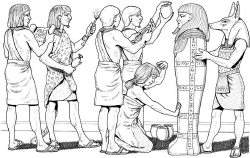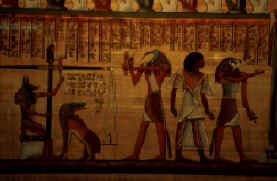

The air in the embalming chamber was
solemnly silent and heavy with fragrant incense.
A tall man with the head of a black jackal entered the room and moved
toward the body on the table. The
man was a priest, dressed in the ceremonial mask of Anubis.
He was there to oversee the ritual creation of a mummy.
Ritual of Embalming
Opening of the Mouth Ceremony
Weighing of the Heart Ceremony
How Do We Know That?
The ancient Egyptians worshipped Anubis, the
jackal god of mummification. The
Egyptians believed that Anubis had three very important roles to play when a
person died. First, he watched over
the embalming procedures. Then, he
presided over the “opening of the mouth” ceremony.
Finally, Anubis led the soul of the dead person to the “weighing of the
heart ceremony.”
Ritual of Embalming
Ancient Egyptians performed an elaborate embalming ritual to preserve the
bodies of the deceased for the Afterlife. The
chief priest represented Anubis during the embalming ritual by wearing a jackal
mask. He cut open the body and
removed the internal organs. He
also read spells from the Book of the Dead to ward off evil spirits.
Opening of the Mouth
Ceremony
An Egyptian funeral could not take place without the “opening of the
mouth” ceremony. This ceremony
was thought to help the dead person’s spirit, called a Ka, return to the body.
The “opening of the mouth” ceremony took place right outside the
tomb. The coffin was stood upright
so that the chief priest, wearing an Anubis mask, could sprinkle water on it.
The priest also recited prayers, made offerings to the gods and touched
the coffins painted mouth, eyes and ears. Egyptians
believed that this important ceremony allowed the dead person to eat, drink and
move about in the next world.
Weighing of the Heart
Ceremony
 Anubis’ most important role was in the “weighing of the heart”
ceremony. Egyptians believed that
when they died, Anubis would lead them across a desert to the Hall of Judgment.
In this place, the person’s heart would be placed on a scale.
On the other side of the scale would be a feather, representing Ma’at,
the goddess of justice. If the
heart and the feather were balanced, the person had led a just life and could
move on to the next world. If the
heart was heavier than the feather, the person would be punished for an unjust
life. Anubis would throw the wicked
heart to the monster Ammit, called the “devourer of the dead.” An unjust person was not permitted to live on in the
Afterworld.
Anubis’ most important role was in the “weighing of the heart”
ceremony. Egyptians believed that
when they died, Anubis would lead them across a desert to the Hall of Judgment.
In this place, the person’s heart would be placed on a scale.
On the other side of the scale would be a feather, representing Ma’at,
the goddess of justice. If the
heart and the feather were balanced, the person had led a just life and could
move on to the next world. If the
heart was heavier than the feather, the person would be punished for an unjust
life. Anubis would throw the wicked
heart to the monster Ammit, called the “devourer of the dead.” An unjust person was not permitted to live on in the
Afterworld.
How Did We Know
That?
Anubis
took on the form of a jackal because jackals were often associated with ancient
Egyptian burial places. Since not
every body was protected by a secure tomb, jackals often prowled Egyptian
cemeteries looking for food. With
Anubis, jackals lost their reputation as scavengers and became known as
protectors of the dead.
Top Of Page
Some images on this page are © 2000-2001 www.arttoday.com.